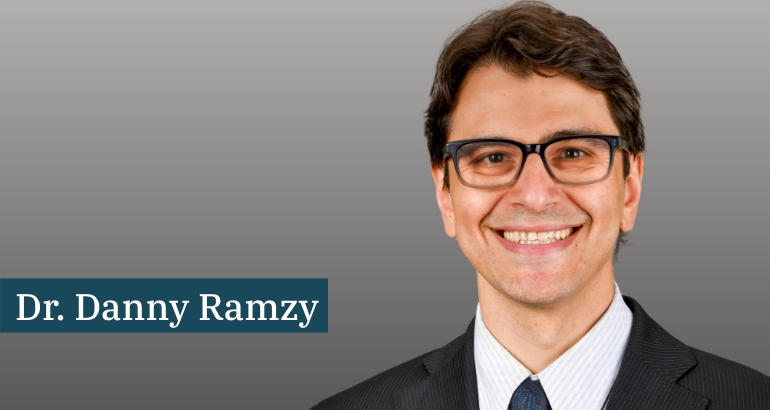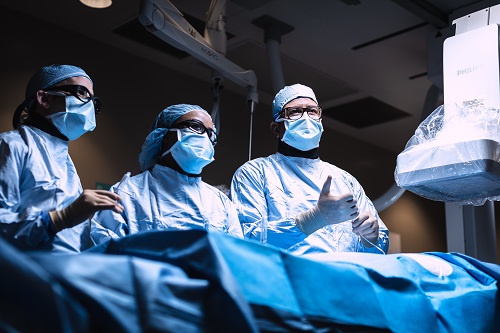Revolutionizing Minimally Invasive Cardiac Surgery with Robotics
Dr. Danny Ramzy shares advancements in robotic-assisted cardiac surgery as well as the different types of robotic-assisted cardiac surgical procedures he performs. He explains who is a candidate and describes the benefits of robotic surgery to the patient. Dr. Ramzy discusses Memorial Hermann’s robotic-assisted surgery program and what sets it apart.

Revolutionizing Minimally Invasive Cardiac Surgery with Robotics
Dr. CorinnCross (Host): Advancing health, personalizing care. At Memorial Hermann, this is our mission. This podcast shares the science and stories behind those efforts. Welcome, I'm Dr. Corinn Cross. Today we'll be discussing advancements in robotic cardiac surgery and the innovative robotic program at Memorial Hermann. Joining us is Dr. Danny Ramzy, professor and chief of the Division of Cardiac Surgery, Director of Robotics in the Department of Cardiothoracic and Vascular Surgery at McGovern Medical School at UTHealth Houston, and medical and surgical director of the Heart & Vascular Institute at Memorial Hermann Memorial City Medical Center. Dr. Ramzy, thank you for joining us.
Dr. Ramzy: Thank you. My pleasure to be here.
Host: So let's start with just a basic high level question. What exactly is robotic-assisted heart surgery?
Dr. Ramzy: That is an excellent question. A lot of people are wondering what does it mean? Is the robot doing the operation? Or is the surgeon doing the operation? So robotic cardiac surgery is when the cardiac surgeon uses a robotic platform and it's a robot that has several arms that we place through small incisions into the chest cavity to be able to perform heart surgery. The surgeon sits at the console and controls the robot. So there's nothing that's done independently by the machine. It's all driven by the surgeon, and the surgeon's doing the case exactly as they would in the standard fashion, except now they're sitting next to the patient in the operating room on a console where they see the image magnified and in 3D, and they're able to do the operations through incisions that are half an inch long.
Host: So that I understand correctly, what surgery modalities is the robotic-assisted heart surgery actually replacing?
Dr. Ramzy: So the advantage of the robot and the robotic platform is it replaces the need to make big incisions and it also replaces the need for us to go through the front in terms of through the sternum, which is the front of the chest, sawing through the breast bone and doing the operation that way. With the robotic approach, we're able to operate through the side in between the ribs, through smaller incisions and less trauma. And therefore, it replaces the need for the surgeon to place their or even larger instruments. Now, we're able to do the operation with great visualization through very small incisions and it’s a lot less traumatic for the patient. It's also a lot more cosmetic, but that's sort of a secondary benefit. The main benefit of this operation is it's less traumatic, less pain and a much quicker recovery than the standard operation.
Host: I understand. So like in my mind I was thinking a robot as this big thing, but in fact the robot is small and so that's why it's able to get into a space where your actual fingers can't get there. So you don't have to make an incision where you could put your scalpel or your clamps actually in there. The robot is so small that it can fit in between your ribs.
Dr. Ramzy: So yes and no. So the robot itself, the whole robot machine is very large, but the part that we place into the patients are very small. And the large part is outside of the patient. And the part that goes into the patient goes through these ports, so these tubes that are 8 millimeters in diameter. So that is this advantage, is you could do the operation as if your wrist was inside the chest, but it's inside with instruments that are very small.
Host: That's amazing. And so when is robotic-assisted cardiac surgery the best option? And who is a candidate for this type of surgery?
Dr. Ramzy: The evolution on the type of surgeries we're able to do with the robotic platform has evolved. And now, most cardiac diagnosis could be treated with a robotic approach, and it just depends on the surgeon's experience and expertise. And also, as you said, who are the candidates? Most patients are. So the question now is no longer who's a candidate for a robotic approach, it's who is not? So you see the patient and some patients because of their anatomy, their comorbidity or past surgical history, or the extent of the operation they need, they're no longer a candidate for robotic heart surgery. But a vast majority of the patients we see are candidates and they would benefit from that approach.
Host: Got it. And you sort of touched on this, but can you walk me through what's happening during the surgery? So the patient comes in and you said, instead of going through the front, you're going to go through the back or the side, right in between the ribs. Are you making that first incision yourself with your hands and then with the robot? Are you using the robot right from the very beginning?
Dr. Ramzy: That's a very excellent question. So we, as the surgeons, pick the spots where we make our incisions and we make the initial centimeter incisions and place the ports in there. And then, we place the instruments and then we dock the robot to those ports that have the instruments. And then, we sit at the console and do the operation with the robot.
Host: That makes sense. And then, again, you also said this a little bit in passing, but when you use robotic assistance, what kind of visuals can you get of the interior of the heart that you're able to capture that you wouldn't be able to see with the naked eye or if you were doing a different type of surgery without robotic assistance?
Dr. Ramzy: The advantage with the newer robotic platform, one, is we have depth perception because operating with small instruments and with a camera, the laparoscopic approach has been done for many, many years, for the last two decades or more. And the difference is pictures were in two-dimension and also the instruments we used lacked the ability to do certain movements. We lost some degrees of freedom because there's no wrist there. With the robot, the instruments have a wrist, so we have our degrees of freedom as if we're operating with our normal instruments and normal hand gestures. And the image is in 3D, so there's two cameras in that tube and we're able to magnify and digitally zoom in the image. We can move the camera as we want to, because it's part of the arm of the robot as well. So we could see these images magnified. For example, the mitral valve, we see great pictures and it really facilitates our ability to repair these valves with the robotic platform with a great visualization compared to doing it through the regular way where we're a little bit further removed from the valve and we're seeing it at an off angle compared to when we see it with the robotic approach.
Host: That's amazing because I understand what you're saying. I've seen laparoscopic surgeries and you have, like, just basically a static camera sitting there and you're trying to work around it and use that as your visual. And what you're describing is something that's much more dynamic, that you almost just, like, you move your eyes in real life, you can see everything you need to see in real time and not have anything be hidden from you.
Dr. Ramzy: Yes, the robotic approach definitely has that advantage and we could just with a press of a button get a four times magnification if we would like. So that is really a true benefit, especially when we're talking about mitral valve repairs because we get a very great view right in front of us. So when we sit down, we look in through the console, we see the valve right in front of us and we can make decisions on what kind of repair we need to do.
Host: That's wonderful. You mentioned mitral valve repair, but what other different types of surgery are you able to perform this way?
Dr. Ramzy: The surgical repertoire that can be done now for cardiac surgery with the robot has truly expanded over the last five years. We could do bypass surgery. We could do not only mitral valve repairs, but we could do mitral valve replacements, tricuspid valve repairs, tricuspid valve replacements. We could close holes in the heart. You know, ASDs and PFOs can be done that way. Cardiac tumors, either in the ventricle, or in the atrium, can be removed using the robotic platform. We could put pacemaker leads. We could do pericardial windows, which drain fluid that's around the heart. In the last couple of years, we're starting to use the robot to do aortic valve replacements. So truly, the platform is starting to be used for all kinds of cardiac diseases and is increasing year by year.
Host: Yeah, it certainly sounds like you're able to do quite a lot with it. What is the process that a patient has to go through to have surgery like this? How is it different than if they were having just standard surgery?
Dr. Ramzy: The workup for most patients are very similar to if they had a standard approach surgery compared to a robotic surgery, except for in a robotic surgery, we always get a CT scan of the body, chest, the abdomen, the pelvis on every patient, whereas it's not always necessary for the non-robotic cases. Otherwise, the workup is identical for those two procedures. And so when patients come see us, we can make a decision and there's no added steps that they have to go through other than getting a CT scan, that may be an added step for the patient. So the patient's referral pathway, what's more important is that they get referred to a surgeon that utilizes robotic approaches.
Host: Exactly. And then for outcomes, you talked about smaller incisions, I would assume that translates to decreased recovery time?
Dr. Ramzy: Yeah, so smaller incisions, but more importantly also without having to spread the ribs to be able to do the operation. You could do these operations less invasively through the side with small incisions without the robot. You could do it with the robot. But if you spread the ribs so you could be able to do this operation, then they tend to have a little bit more pain. The robot allows you to be able to do these operations without spreading the ribs, even if you make a larger incision. And that's where the quicker recovery comes. The operation is a lot less traumatic. There's no rib-spreading. We also utilize other pain control strategies where we numb the nerves that feed those ribs. And so these patients have a much quicker recovery. We take the breathing tube from the patient before they leave the operating room. They usually go to the ICU and then they leave and they go home usually on average on the third day.
Host: That's really impressive. I'm sure your patients are really thrilled with that type of recovery and not having their ribs spread, which sounds just painful talking about it. Are the outcomes the same? Are they better? Are they the same? What are you finding?
Dr. Ramzy: So if we look historically, the main criticism was that the outcomes weren't as good with the robotic platform, but that is sort of historical. When you look at the data now, the robotic approach and centers and surgeons that utilize the robotic approach actually have better outcomes. And that's mostly driven by expertise, not only expertise in being able to do the robotic approach and now we're doing a lot better. It's also better robotic tools. And finally, it's experience. The more you do mitral valves, the more mitral valves you repair, the better your results are. And when you look at robotic surgeons, they tend to have a larger practice for every specific disease type they do, and their results are better than the average.
Host: So let's talk about that. What differentiates Memorial Hermann's Robotic Assisted Cardiac Surgery Program from others in the region?
Dr. Ramzy: So there are not many robotic programs in the region, and there's not a lot of robotic programs across the country — about 5% of surgeries are done robotically. The differentiating factor with our program is that we offer all that can be done with a robotic platform for cardiac surgery. We're not just a mitral valve repair center, or we're not just a bypass center or mitral valve repair and bypasses. We offer everything that can be done robotically. There are programs similar to this across the country, but there are very few. Most programs offer a very niche practice in terms of what they offer with the robotic platform. And here, we offer the entire spectrum that can be done. So we see patients and we make a decision. Are they a robotic candidate? Yes, no. And if they are, we do it. And if they're not, then we do the case minimally invasively. And that's the other advantage, if not robot, then we do the operation in the standard way. If it's robotic, the other question is can we do it less invasively without the robot? And the last avenue is we do it in a regular way, and some patients do. Some patients because of their anatomy and their disease process, we need to do it in a standard way, but that's an exception. That's less than 10% of our practice.
Host: Right. So I mean, obviously, it's the same with every surgery. You want to find the right fit for the right patient. And when patients are looking, they want to go someplace that has the experience in doing it and does a lot of these every year.
Dr. Ramzy: That is correct. A very important factor for outcomes is volume and experience. And that's sort of what patients should be looking at, is centers that have the experience, that have the data and have the numbers and the results that are really exceptional, especially when it comes to mitral valve repairs. And that is sort of something that the patients need to focus on and look at and, of course, being able to do it robotically adds to the quicker recovery for the patients.
Host: Yeah, it's the most minimally invasive. And it seems like even besides being minimally invasive, it really gives you that added benefit of being able to zoom in and be so precise with little, itty bitty instruments that are smaller than what we could do with our own hands. So it's really impressive what you're doing there. Is there anything else in summary that you would like to share or add for our listeners today?
Dr. Ramzy: Yes, I'd like to say the heart surgery has evolved. It's no longer all patients are being treated with this big incision down the chest, which most patients refer to as, "Are you going to crack my chest open?" And so that's not the standard for all patients. And not to be afraid of coming to see a heart surgeon. I think a lot of patients are reluctant to sometimes have surgery because of the invasiveness, and that I'd like patients to know that there are less invasive ways diseases are being treated now and they should get a referral and get seen and get an opinion. And also, if they believe they could be a minimally invasive option for them and they were told, "We can't do it," they always could seek a second opinion in a center that does a large volume of these cases to be sure that their case can or cannot be done less invasively.
Host: That's really good advice and what an exciting time to be in your field. It's so impressive what you're doing and so impactful for patients. Because like you said, this can be life-changing, and putting your head in the sand and not going to see a surgeon or getting a second opinion because you're nervous, it never turns out well. So getting the information is always what we would recommend for patients. But thank you, Dr. Ramzy for joining us and sharing so much of your time and your expertise with us today. It was a pleasure speaking with you.
Dr. Ramzy: Thank you very much. I had a great time and thank you for having me on and being able to share what we do here and to be able to let the patients and the community know what could be offered and what is robotic heart surgery.
Host: Thank you. To learn more about robotic cardiac surgery, visit Memorial Hermann website at memorialhermann.org/heart. That's Memorial Hermann with two N's. That concludes this episode of Advance, the podcast series for Memorial Hermann. If you found this podcast helpful, please share it on your social channels and be sure to check out the entire podcast library for other topics that might interest you. Please remember to subscribe, rate, and review this podcast. Thanks for listening to this episode of Advance. I'm your host, Dr. Corinn Cross.


